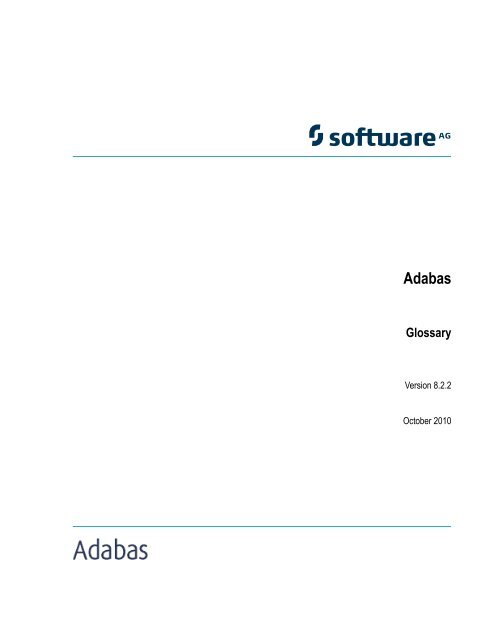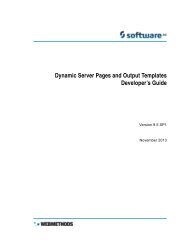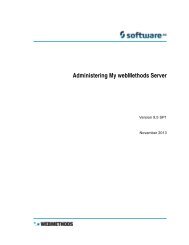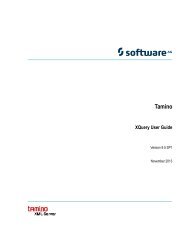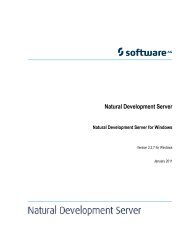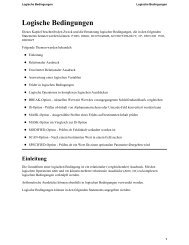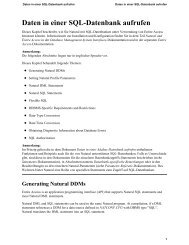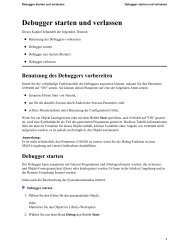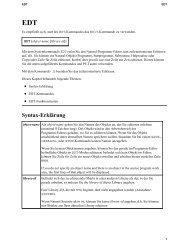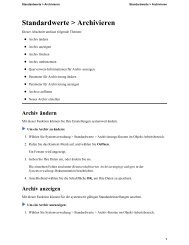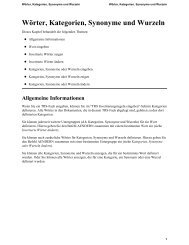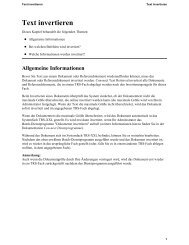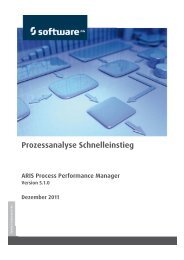Adabas Glossary - Software AG Documentation
Adabas Glossary - Software AG Documentation
Adabas Glossary - Software AG Documentation
Create successful ePaper yourself
Turn your PDF publications into a flip-book with our unique Google optimized e-Paper software.
<strong>Adabas</strong><br />
<strong>Glossary</strong><br />
Version 8.2.2<br />
October 2010
This document applies to <strong>Adabas</strong> Version 8.2.2.<br />
Specifications contained herein are subject to change and these changes will be reported in subsequent release notes or new editions.<br />
Copyright © 1971-2010 <strong>Software</strong> <strong>AG</strong>, Darmstadt, Germany and/or <strong>Software</strong> <strong>AG</strong> USA, Inc., Reston, VA, United States of America,<br />
and/or their licensors.<br />
The name <strong>Software</strong> <strong>AG</strong>, webMethods and all <strong>Software</strong> <strong>AG</strong> product names are either trademarks or registered trademarks of <strong>Software</strong> <strong>AG</strong><br />
and/or <strong>Software</strong> <strong>AG</strong> USA, Inc. and/or their licensors. Other company and product names mentioned herein may be trademarks of<br />
their respective owners.<br />
Use of this software is subject to adherence to <strong>Software</strong> <strong>AG</strong>'s licensing conditions and terms. These terms are part of the product documentation,<br />
located at http://documentation.softwareag.com/legal/ and/or in the root installation directory of the licensed product(s).<br />
This software may include portions of third-party products. For third-party copyright notices and license terms, please refer to "License<br />
Texts, Copyright Notices and Disclaimers of Third-Party Products". This document is part of the product documentation, located at<br />
http://documentation.softwareag.com/legal/ and/or in the root installation directory of the licensed product(s).
Table of Contents<br />
<strong>Glossary</strong> .............................................................................................................................. 1<br />
A ................................................................................................................................. 1<br />
B .................................................................................................................................. 3<br />
C ................................................................................................................................. 4<br />
D ................................................................................................................................. 5<br />
E .................................................................................................................................. 6<br />
F .................................................................................................................................. 6<br />
G ................................................................................................................................. 9<br />
I ................................................................................................................................. 10<br />
L ................................................................................................................................ 11<br />
M ............................................................................................................................... 12<br />
N ............................................................................................................................... 12<br />
O ............................................................................................................................... 13<br />
P ................................................................................................................................ 14<br />
Q ............................................................................................................................... 15<br />
R ................................................................................................................................ 15<br />
S ................................................................................................................................ 16<br />
T ................................................................................................................................ 18<br />
U ............................................................................................................................... 19<br />
V ............................................................................................................................... 20<br />
W .............................................................................................................................. 21<br />
Index ................................................................................................................................. 23<br />
iii
<strong>Glossary</strong><br />
A<br />
ABD list An ABD list is a file containing a list of pointers to the <strong>Adabas</strong> buffer<br />
descriptions to be used for an <strong>Adabas</strong> direct call. ABD lists can only<br />
be used if the direct call is made using the ACBX direct call interface.<br />
For complete information about ABD lists, read ABD Lists, in the<br />
<strong>Adabas</strong> Command Reference Guide.<br />
ACB interface direct call The ACB direct call interface is the classic direct call interface, used<br />
for <strong>Adabas</strong> releases prior to <strong>Adabas</strong> version 8. Direct calls in this<br />
format require the use of the classic <strong>Adabas</strong> control block (ACB). If<br />
you have been using releases of <strong>Adabas</strong> prior to <strong>Adabas</strong> 8, the direct<br />
calls used by your applications use the ACB direct call interface.<br />
For information about <strong>Adabas</strong> direct calls, read Calling <strong>Adabas</strong>, in<br />
the <strong>Adabas</strong> Command Reference Guide.<br />
ACBX interface direct call The ACBX direct call interface is the extended direct call interface,<br />
used for <strong>Adabas</strong> releases starting with <strong>Adabas</strong> 8. Direct calls in this<br />
format require the use of the extended <strong>Adabas</strong> control block (ACBX).<br />
If you have purchased and installed <strong>Adabas</strong> 8 (or later), you can use<br />
this format of direct call in your applications. Otherwise, you cannot.<br />
For information about <strong>Adabas</strong> direct calls, read Calling <strong>Adabas</strong>, in<br />
the <strong>Adabas</strong> Command Reference Guide.<br />
<strong>Adabas</strong> <strong>Adabas</strong>, the adaptable data base, is a high-performance, multithreaded,<br />
database management system for mainframe platforms<br />
where database performance is a critical factor. It is interoperable,<br />
scalable, and portable across multiple, heterogeneous platforms including<br />
mainframe, midrange, and PC.<br />
<strong>Adabas</strong> buffer description<br />
(ABD)<br />
An <strong>Adabas</strong> buffer description (ABD) describes a buffer segment used<br />
in a direct call. Specifically, it identifies the buffer type (format, record,<br />
multifetch, search, value, ISN, performance, or user), location,<br />
1
<strong>Glossary</strong><br />
<strong>Adabas</strong> direct access method<br />
(ADAM)<br />
size, and other pertinent information. The buffer itself or a pointer<br />
to the buffer may be included in the ABD. ABDs may only be used<br />
if buffers are required for an <strong>Adabas</strong> direct call that is made using<br />
the ACBX direct call interface provided with <strong>Adabas</strong> 8 (or later);<br />
they cannot be used if buffers are required for an <strong>Adabas</strong> direct call<br />
made using the ACB direct call interface.<br />
For complete information about the structure of ABDs, read <strong>Adabas</strong><br />
Buffer Descriptions (ABDs), in the <strong>Adabas</strong> Command Reference Guide.<br />
For information about <strong>Adabas</strong> direct calls, read Calling <strong>Adabas</strong>, in<br />
the <strong>Adabas</strong> Command Reference Guide.<br />
The <strong>Adabas</strong> direct access method (ADAM) facility permits the retrieval<br />
of records directly from Data Storage without accessing the<br />
inverted lists. The Data Storage block number in which a record is<br />
located is calculated using a randomizing algorithm based on the<br />
ADAM key of the record. The use of ADAM is completely transparent<br />
to application programs and query and report writer facilities.<br />
Read Random Access Using the <strong>Adabas</strong> Direct Access Method (ADAM),<br />
in <strong>Adabas</strong> Concepts and Facilities Manual, for more information.<br />
<strong>Adabas</strong> session The <strong>Adabas</strong> session starts when the nucleus is invoked and ends when<br />
the nucleus is terminated. An <strong>Adabas</strong> nucleus is invoked using job<br />
control specific to a particular operating system that contains <strong>Adabas</strong><br />
startup, or ADARUN, parameters.<br />
<strong>Adabas</strong> trigger driver Part of the <strong>Adabas</strong> nucleus that has overall control of the <strong>Adabas</strong><br />
triggers and stored procedures facility. It detects trigger and stored<br />
procedure requests and initializes the Natural trigger driver to execute<br />
them.<br />
Adalink A generic term for that part of the <strong>Adabas</strong> API (application program<br />
interface) that is specific to a particular teleprocessing (TP) monitor.<br />
The <strong>Adabas</strong> API is used to link application programs to <strong>Adabas</strong>.<br />
The actual module name depends on the TP monitor being used;<br />
for example, the module name for linking to a batch or TSO program<br />
is ADALNK and for CICS, the module name is ADALNC.. The term<br />
Adalink refers to the module appropriate for the given environment.<br />
The terms Adalink(s) and ADALNK(s) are synonyms.<br />
ADARUN The ADARUN control statement defines and starts the <strong>Adabas</strong> operating<br />
environment. The ADARUN control statement also starts<br />
<strong>Adabas</strong> utilities.<br />
2<br />
ADARUN:<br />
<strong>Glossary</strong>
■ loads the ADAIOR module, which performs all database I/O and<br />
other operating-system-dependent functions;<br />
■ interprets the ADARUN parameter statements; then loads and<br />
modifies the appropriate <strong>Adabas</strong> nucleus or utility modules according<br />
to the ADARUN parameter settings; and<br />
■ transfers control to <strong>Adabas</strong>.<br />
The ADARUN statement, normally a series of entries each specifying<br />
one or more ADARUN parameter settings, is specified in the<br />
DDCARD (z/OS or BS2000) or VSE CARD data set.<br />
address converter <strong>Adabas</strong> stores each database record in a Data Storage block identified<br />
by a relative <strong>Adabas</strong> block number (RABN). Each record's RABN is<br />
kept in a table called the address converter. The address converters,<br />
one for each database file, are stored in the Associator. Address<br />
converter entries are in ISN order (that is, the first entry tells the<br />
RABN location of data for ISN 1, the 15th entry holds the RABN<br />
location of data for ISN 15, and so on).<br />
If spanned records are used, a secondary address converter is used<br />
to map the secondary ISNs to the RABNs of the Data Storage blocks<br />
where the secondary records are stored.<br />
address space The storage area assigned to a program task/work unit. In z/OS, an<br />
address space is a region; in VSE, a partition; and in BS2000, a task.<br />
In this documentation, the term region is used as a synonym for<br />
partition and task.<br />
anchor file In an expanded file, the anchor file is the file with the lowest ISN<br />
range. The anchor file's file number is the number assigned the entire<br />
expanded file.<br />
For more information, read Linking Physical Files in a Single Logical<br />
File and Expanded Files in <strong>Adabas</strong> DBA Tasks Manual.<br />
asynchronous trigger An asynchronous trigger executes independently of the initiating<br />
<strong>Adabas</strong> command. <strong>Adabas</strong> command processing for the user continues<br />
uninterrupted while the triggered procedure executes as a separate<br />
process. The triggered procedure may execute after the user<br />
has already received the response from the initiating command.<br />
B<br />
<strong>Glossary</strong><br />
Contrast this trigger type with a synchronous trigger.<br />
<strong>Glossary</strong><br />
3
<strong>Glossary</strong><br />
base file When dealing with large object (LB) fields, <strong>Adabas</strong> stores the LB<br />
field values in a separate file, called a LOB file, that is tightly associated<br />
with the file containing the LB fields, which is called the base<br />
file. Behind the scenes, <strong>Adabas</strong> will store LB field values (except for<br />
very short ones) in the LOB file, but this is transparent to your application.<br />
Commands in application programs should always be<br />
directed against the base file; application programs need neither<br />
know nor care about the existence of a LOB file.<br />
binary occurrence counter<br />
(BOC)<br />
For more information, read Large Object (LB) Files and Fields, in <strong>Adabas</strong><br />
DBA Tasks Manual.<br />
The binary occurrence counter (BOC) stores the number of occurrences<br />
or multiple-value (MU) and periodic group (PE) fields in a file.<br />
BUB The block of unreadable blocks. It is contained in the primary ASSO<br />
RABN 2 and the mirror ASSO RABN 9 for the primary ASSO, DATA,<br />
and WORK; in the primary ASSO RABN 9 and mirror ASSO RABN<br />
2 for the mirror ASSO, DATA, and WORK; and the primary and the<br />
mirror PLOGn RABN 1 for PLOGn.<br />
buffer flush Associator and Data Storage blocks in the buffer pool that have been<br />
updated since the last buffer flush have write flags set on. When the<br />
buffer is flushed, these blocks are written to Associator and Data<br />
Storage data sets, respectively. The flushed blocks remain in the<br />
buffer pool with their write flags set off.<br />
C<br />
A buffer flush can be synchronous or asynchronous. Update commands<br />
cannot be selected during a synchronous flush, but can be<br />
selected during an asynchronous flush.<br />
CICS execution unit CICS applications that use <strong>Adabas</strong> services require an <strong>Adabas</strong> CICS<br />
execution unit to function.<br />
4<br />
Effective with <strong>Adabas</strong> 8.2 and later versions, the <strong>Adabas</strong> CICS execution<br />
unit is comprised of:<br />
■ the <strong>Adabas</strong> CICS stub, ADACICS<br />
■ an <strong>Adabas</strong> CICS names module, ACINAMES<br />
■ one or more <strong>Adabas</strong> task-related user exits (TRUEs), ADACICT<br />
■ a globals table associated with the stub module and the TRUE.<br />
<strong>Glossary</strong>
command ID The command ID is an automatically generated or user-specified<br />
nonblank, nonzero value that:<br />
■ Prevents repetitive format buffer decoding by acting as an internal<br />
ID for decoded record formats;<br />
■ Tags ISN lists generated by the Sx command for later access, and<br />
saves ISN list overflow.<br />
It is specified in <strong>Adabas</strong> control block fields (ACBCID or ACBXCID).<br />
For more information about command IDs, read Command, Format,<br />
and Global Format IDs, in the <strong>Adabas</strong> Command Reference Guide.<br />
communicator A routine for communicating between operating systems, making<br />
remote targets accessible. Entire Net-work is a communicator.<br />
compressed records <strong>Adabas</strong> retains data records in compressed form, using several different<br />
compression options. Data compression significantly reduces<br />
the amount of storage required by the data in a database. It also<br />
permits transmission of more information per physical transfer,<br />
resulting in greater I/O efficiency.<br />
D<br />
For complete information on data compression in <strong>Adabas</strong>, read<br />
Compression, in <strong>Adabas</strong> Concepts and Facilities Manual.<br />
data compression Data compression significantly reduces the amount of storage required.<br />
It also permits the transmission of more information per<br />
physical transfer, resulting in greater I/O efficiency.<br />
<strong>Adabas</strong> retains data records in compressed form. Several compression<br />
options are supported. For complete information, read Compression,<br />
in <strong>Adabas</strong> Concepts and Facilities Manual.<br />
database In <strong>Adabas</strong>, a database is a group of related files.<br />
database administrator<br />
(DBA)<br />
<strong>Glossary</strong><br />
<strong>Glossary</strong><br />
A physical database identified by its database ID number (DBID) is<br />
defined with <strong>Adabas</strong> utilities. A single physical database is one set of<br />
Associator and Data Storage data sets identified by a single DBID.<br />
An <strong>Adabas</strong> nucleus running in an address space allows access to<br />
the physical files in the physical database.<br />
Controls and manages the database resources. Tasks include defining<br />
database distribution, assigning a structure and resources, creating<br />
and maintaining programming and operation standards, ensuring<br />
high performance, resolving user problems, defining and teaching<br />
5
<strong>Glossary</strong><br />
user training, controlling database access and security, and planning<br />
for growth and the integration of new database resource applications<br />
and system upgrades. Also known as the database analyst.<br />
descriptor A descriptor is a search key. A unique descriptor has a different (i.e.,<br />
unique) value for each record in the file. Entries are made in the<br />
Associator's inverted list for descriptor fields, adding disk space and<br />
processing overhead requirements.<br />
E<br />
Any field can be used within a selection criterion. When a field that<br />
is used extensively as a search criterion is defined as a descriptor<br />
(key), the selection process is considerably faster since <strong>Adabas</strong> is<br />
able to access the descriptor's values directly from the inverted list<br />
without reading any records from Data Storage.<br />
A descriptor field can be used as a sort key in a search command,<br />
as a way of controlling a logical sequential read process (ascending<br />
or descending values), or as the basis for file coupling.<br />
A portion of a field may be defined as a subdescriptor; combinations<br />
of fields or portions thereof may be defined as a superdescriptor; a<br />
user-supplied algorithm may be the basis of a hyperdescriptor or a<br />
collation descriptor; and a sounds-like encoding algorithm may be the<br />
basis of a phonetic descriptor, which may be customized for specific<br />
language requirements. For more information, see <strong>Adabas</strong> Design in<br />
the Concepts and Facilities.<br />
elementary field An elementary field has only one value per record.<br />
expanded file To reduce the number of files accessed, <strong>Adabas</strong> allows you to link<br />
multiple physical files containing records of the same format together<br />
as a single logical file. This file structure is called an expanded file,<br />
and the physical files comprising it are the component files. An expanded<br />
file can comprise up to 128 component files, each with a<br />
unique range of logical ISNs. An expanded file cannot exceed<br />
4,294,967,294 records.<br />
F<br />
For more information, read Linking Physical Files in a Single Logical<br />
File and Expanded Files in <strong>Adabas</strong> DBA Tasks Manual.<br />
field In <strong>Adabas</strong>, a field is the smallest logical unit of information (e.g.,<br />
current salary) that may be defined and referenced by the user.<br />
6<br />
<strong>Glossary</strong>
<strong>Adabas</strong> supports four field types:<br />
Single Field<br />
Single Value per Record<br />
Elementary<br />
Multiple Fields Group<br />
Multiple Values per Record<br />
MU<br />
PE<br />
The two basic field types are elementary and multiple-value. An<br />
elementary field has only one value per record. A multiple-value (MU)<br />
field can have up to about 65,534 values, or occurrences, in a single<br />
record. Each multiple-value field has a binary occurrence counter<br />
(BOC) that stores the number of occurrences.<br />
When two or more consecutive fields in the FDT are frequently accessed<br />
together, you can reference them by defining a group field.<br />
Other than its level and <strong>Adabas</strong> short name, a group field has no<br />
attributes defined. It immediately precedes its member fields in the<br />
FDT. A higher field level number is used to assign the member fields<br />
to the group field. <strong>Adabas</strong> supports up to seven field levels.<br />
A periodic (PE) group field defines consecutive fields in the FDT that<br />
repeat together in a record. Like the members of a normal group<br />
field, PE members immediately follow the PE group field, have a<br />
higher level number than the PE field, and can be accessed both individually<br />
and as a group. Each PE has a BOC that stores the number<br />
of occurrences. A periodic group may be repeated up to about 65,534<br />
times per record and may contain one or more multiple-value fields.<br />
The actual limit to the number of occurrences of MU fields and PE<br />
groups is derived from the maximum data storage record length<br />
(the ADALOD MAXRECL parameter), which defaults to the size of<br />
the data storage block minus 4.<br />
Field definition table (FDT) A table that defines each file's record structure and content. There<br />
is one FDT for each database file. FDTs, stored in the Associator's<br />
fixed area, have three parts: the first is a list of the file's fields in<br />
physical record order, the second part is a quick index to the records<br />
in the first part, and the third part defines the files sub/superfields<br />
and sub-/super-/hyper- and phonetic descriptors.<br />
<strong>Glossary</strong><br />
<strong>Glossary</strong><br />
A portion of a field ( subfield ) or any combination of fields ( superfield<br />
) may be defined as an elementary field. Subfields and superfields<br />
may be used for read operations only. They may only be changed<br />
by updating the original fields.<br />
7
<strong>Glossary</strong><br />
file In <strong>Adabas</strong>, a file is a group of related records that have the same<br />
format (with some exceptions; see <strong>Adabas</strong> Design in the Concepts and<br />
Facilities).<br />
The disk storage space allocated to a single <strong>Adabas</strong> database is segmented<br />
into logical <strong>Adabas</strong> files. A certain part of the overall space<br />
within the database is allocated to each logical file. When this space<br />
is filled with records from that file, <strong>Adabas</strong> automatically allocates<br />
more space to the file from the common free space pool. This dynamic<br />
space allocation, together with the dynamic recovery of released<br />
space, allows <strong>Adabas</strong> databases to run without intervention for long<br />
periods of time.<br />
A physical <strong>Adabas</strong> file contains database records. Each physical file<br />
is identified by a file number. The number of physical files (and<br />
physical file numbers) per physical database is limited to 5000 or<br />
one less than the ASSOR1 block size, whichever is lower.<br />
An expanded file is a logical file comprising physical files in one or<br />
more locations. The physical files have the same field definition table<br />
(FDT), but non-overlapping ISN ranges. The data content of at least<br />
one field (the field value criterion) determines the physical file in<br />
which a data record is located.<br />
A multiclient file is an <strong>Adabas</strong> file with records accessible through<br />
an owner ID. Only records identified by the same individual or<br />
group owner ID can be accessed or updated by the related user. This<br />
allows the file to be maintained as a single <strong>Adabas</strong> file, but to be<br />
used as multiple logical files (each record group belonging to an<br />
owner ID is a logical file). Super owner IDs allow access to all records<br />
in the file.<br />
file control blocks (FCBs) The control block <strong>Adabas</strong> assigns to each file in a database. There is<br />
one FCB per file. The FCB identifies the file's physical location and<br />
associated RABNs. The FCBs are part of the Associator.<br />
format ID The format ID is an ID that is assigned a decoded format buffer. The<br />
format buffer is stored once for each user and can then be referenced<br />
by its format ID and reused. Individual format IDs are stored once<br />
for each user and used only by that user. The format buffers are<br />
identified by a combination of unique format ID and terminal ID.<br />
8<br />
Contrast this with global format IDs which store a decoded format<br />
buffer once globally and share it with many users running on the<br />
same <strong>Adabas</strong> nucleus.<br />
<strong>Glossary</strong>
G<br />
general control blocks<br />
(GCBs)<br />
The format ID is specified in <strong>Adabas</strong> control block fields (ACBADD5<br />
or ACBXADD5). For more information about format IDs, read<br />
Command, Format, and Global Format IDs, in the <strong>Adabas</strong> Command<br />
Reference Guide.<br />
The two control blocks <strong>Adabas</strong> assigns to each database. The GCBs<br />
identify the database and where it resides. The GCBs are part of the<br />
Associator.<br />
generation Information is stored on the Recovery log (RLOG) by generation,<br />
the logical unit used for recovery. A generation includes all activity<br />
between consecutive operations of:<br />
■ ADASAV SAVE/RESTORE (database),<br />
■ RESTORE GCB, or<br />
■ SAVE DELTA/RESTORE DELTA (database).<br />
For more information, read Generation: The Unit of Recovery in <strong>Adabas</strong><br />
Utilities Manual.<br />
global format ID A global format ID is an ID that is assigned a decoded format buffer.<br />
The format buffer is stored once globally and can then be referenced<br />
by its format ID and reused. Global format IDs are stored once<br />
globally and can be used by any user running on the same <strong>Adabas</strong><br />
nucleus. The format buffers are identified by a unique format ID.<br />
Contrast this with format IDs which store a decoded format buffer<br />
once for each user and are used only by that user.<br />
The global format ID is specified in <strong>Adabas</strong> control block fields<br />
(ACBADD5 or ACBXADD5). For more information about format<br />
IDs, read Command, Format, and Global Format IDs, in the <strong>Adabas</strong><br />
Command Reference Guide.<br />
global parameters Some ADARUN parameters are global parameters; that is, they must<br />
have the same values for all nuclei in a cluster. In addition, some of<br />
the global parameters are set at session initialization and cannot be<br />
changed.<br />
global transaction A global transaction is a unit of work that involves changes to resources<br />
under the control of more than one database operating in<br />
one or more operating system images.<br />
<strong>Glossary</strong><br />
<strong>Glossary</strong><br />
9
<strong>Glossary</strong><br />
I<br />
ID An abbreviation of target ID, a unique identifier used for directing<br />
<strong>Adabas</strong> calls to their targets.<br />
ID table A reference data list maintained for all active targets within the<br />
boundaries of one operating system. The ID table is located in commonly<br />
addressable storage.<br />
IIBS The isolated ID bit string, a 256-bit (32-byte) string contained in the<br />
ID table header. Each bit corresponds in ascending order to a logical<br />
ID. If the bit has the value "1", the corresponding ID is isolated.<br />
I/O buffer The <strong>Adabas</strong> I/O buffer area, which can be resized for each <strong>Adabas</strong><br />
session, contains the most frequently used data and data relationships;<br />
it helps to minimize physical input/output (I/O) activity and<br />
thus saves computer time. It is loaded into main memory at startup,<br />
along with the <strong>Adabas</strong> nucleus.<br />
internal sequence number<br />
(ISN)<br />
The buffer contains blocks read from the database and blocks to be<br />
written to the database:<br />
For blocks read from the database, a buffer algorithm ensures that the<br />
most frequently accessed blocks stay in memory. When a block from<br />
the database is needed, the buffer content is checked to determine<br />
if the block is already in memory, thus avoiding unnecessary reads.<br />
Multiple updates are accumulated in a block before it is written<br />
(flushed) to external storage.<br />
Every <strong>Adabas</strong> record is assigned an internal sequence number (ISN)<br />
to identify the record. Each record keeps its original ISN, regardless<br />
of where it is located.<br />
Records in a physical database file have four-byte ISNs ranging from<br />
MINISN to MAXISN. In replicated files, a record has the same ISN<br />
in all file copies. In partitioned files, the ISN ranges are non-overlapping<br />
for each physical file.<br />
inverted list A list, organized by descriptor value rather than by ISN which is<br />
used to resolve <strong>Adabas</strong> search commands and read records in logical<br />
sequence. It is built and maintained for each field in an <strong>Adabas</strong> file<br />
that is designated as a key field or descriptor. The list comprises the<br />
normal index (NI) and as many as 14 upper indexes (UI).<br />
isolated ID The ID of an isolated target, which can be specified by the user as a<br />
logical ID. An isolated ID must be greater than zero and less than<br />
10<br />
<strong>Glossary</strong>
256. The isolated ID is interpreted as a physical ID for addressing<br />
the target.<br />
isolated target A target called directly by a user.<br />
L<br />
large object field (LB field) A large object field (LB field) is an alphanumeric field that can have<br />
a theoretical size of up to 2 GB. Such fields can be used, for example,<br />
to store documents (for example, HTML, XML, Microsoft Word, or<br />
PDF documents), pictures (for example JPG or BMP files), or other<br />
data conglomerates in single fields in the database.<br />
For more information, read Large Object Option LB, in <strong>Adabas</strong> Concepts<br />
and Facilities Manual and Large Object (LB) Files and Fields, in <strong>Adabas</strong><br />
DBA Tasks Manual.<br />
LOB file <strong>Adabas</strong> stores large object field values in a separate file, called a LOB<br />
file, that is tightly associated with the file containing the LB fields,<br />
which is called the base file. Behind the scenes, <strong>Adabas</strong> will store<br />
LB field values (except for very short ones) in the LOB file, but this<br />
is transparent to your application. Commands in application programs<br />
should always be directed against the base file; application<br />
programs need neither know nor care about the existence of a LOB<br />
file.<br />
For more information, read Large Object (LB) Files and Fields, in <strong>Adabas</strong><br />
DBA Tasks Manual.<br />
LOB group The combination of a base file and its associated LOB file is referred<br />
to as a LOB group.<br />
logical ID A user’s identifier of targets to which a message is directed. It must<br />
be greater than "0" and less than "256" (either explicitly or implicitly,<br />
the content of the first byte of ACBFNR is a logical ID).<br />
logical duplication The process of permanently storing information that is implied by<br />
the contents of other records. For example, if a credit control routine<br />
needs the sum of all invoices for its customers, the information can<br />
be quickly accessed if totals have been maintained permanently in<br />
customer records, rather than reading and totaling the relevant invoices<br />
with each request, since that process might involve random<br />
access of a large number of records.<br />
<strong>Glossary</strong><br />
<strong>Glossary</strong><br />
11
<strong>Glossary</strong><br />
logical transaction The smallest unit of work (as defined by the user) that must be performed<br />
in its entirety to ensure that the information contained in<br />
the database is logically consistent.<br />
A logical transaction may comprise one or more <strong>Adabas</strong> commands<br />
that together perform the database read/update required to complete<br />
a logical unit of work. A logical transaction begins with the first<br />
command that places a record in hold status and ends when an ET<br />
(end transaction), BT (back out transaction), CL (close), or OP (open)<br />
command is issued for the same user.<br />
logically deleted fields Fields that have been logically removed from a database file using<br />
the ADADBS DELFN utility function. Logically deleted fields have<br />
been removed from the FDT for the file, but the data for the fields<br />
is retained in the database.<br />
M<br />
MIRTAB The mirror table, which indicates the status of primary RABNs. It<br />
is contained in the primary and the mirror ASSO RABN 7 for ASSO,<br />
DATA, and WORK; and the primary and the mirror PLOGn RABN<br />
1 for PLOGn.<br />
multiple-value (MU) field A multiple-value (MU) field can have multiple values. The number<br />
of occurrences of each MU field in a file can be 191 or up to about<br />
65,534 values, or occurrences, in a single record. The actual limit is<br />
derived from a number of factors. For more information on the actual<br />
limit of MU and PE group fields, read MU and PE Options and Field<br />
Types, in <strong>Adabas</strong> Concepts and Facilities Manual. Each MU field has a<br />
binary occurrence counter (BOC) that stores the number of occurrences.<br />
N<br />
Note: The use of more than 191 MU or PE groups in a record<br />
must be explicitly allowed for a file (it is not allowed by default).<br />
This is accomplished using the ADADBS MUPEX<br />
function or the ADACMP COMPRESS MUPEX and MUPECOUNT<br />
parameters.<br />
Natural trigger driver The Natural nucleus component that runs as a batch Natural environment.<br />
The Natural trigger driver is responsible for the actual execution<br />
of both triggers and stored procedures. Operating in conjunction<br />
with the <strong>Adabas</strong> trigger driver, it handles the interprocess<br />
12<br />
<strong>Glossary</strong>
communications between the <strong>Adabas</strong> nucleus and the Natural subsystem<br />
that executes the procedure.<br />
non-DB target A target that is not an <strong>Adabas</strong> nucleus. Access and X-COM are non-<br />
DB targets.<br />
non-participating trigger A non-participating trigger can be synchronous or asynchronous. It<br />
has a user ID that is different from that of the <strong>Adabas</strong> user queue<br />
element (UQE) that identifies the initiating command; thus, it does<br />
not participate in the initiating command's transaction logic.<br />
Contrast this trigger type with a participating trigger.<br />
normal index (NI) An index for a particular descriptor in the inverted list. The normal<br />
index has an entry for each descriptor value. The entry contains the<br />
value itself, the number of records in which the value occurs, and<br />
the ISNs of those records.<br />
nucleus The nucleus is a set of programs that drive <strong>Adabas</strong>, coordinate all<br />
work, and translate user program statements into <strong>Adabas</strong> commands.<br />
All programs access <strong>Adabas</strong> files through the nucleus. All database<br />
activities such as data access and update are managed by the <strong>Adabas</strong><br />
nucleus. In most cases, a single nucleus is used to manage a single<br />
physical database.<br />
O<br />
<strong>Adabas</strong> Parallel Services makes it possible to run a cluster of up to<br />
31 <strong>Adabas</strong> nuclei on a single operating system against a single<br />
database. <strong>Adabas</strong> Cluster Services supports the IBM parallel sysplex<br />
environment making it possible to run a cluster of up to 32 <strong>Adabas</strong><br />
nuclei on multiple operating systems set up as a sysplex. Again the<br />
cluster runs against a single database.<br />
Note: See Optional Extensions in the Concepts and Facilities for<br />
information about running multiple nuclei against a single<br />
physical database under a single operating system image<br />
(ADASMP) or under multiple z/OS images (Adaplex+).<br />
operator commands <strong>Adabas</strong> operator commands are entered during an <strong>Adabas</strong> session<br />
or during utility operation to:<br />
<strong>Glossary</strong><br />
■ terminate an <strong>Adabas</strong> or user session;<br />
■ display nucleus or utility information;<br />
■ log commands into CLOG;<br />
<strong>Glossary</strong><br />
13
<strong>Glossary</strong><br />
P<br />
■ change <strong>Adabas</strong> operating parameters or conditions.<br />
participating trigger A participating trigger must be synchronous. Such a trigger results<br />
in the execution of a procedure that is assigned the same user ID as<br />
the <strong>Adabas</strong> command that caused the participating trigger to be<br />
fired; thus, it can participate fully in the logic of the transaction.<br />
Contrast this trigger type with a non-participating trigger.<br />
periodic (PE) group field A periodic (PE) group field defines consecutive fields in the FDT that<br />
repeat together in a record. Like the members of a non-periodic<br />
group field, PE members immediately follow the PE group field,<br />
have a higher level number than the PE field, and can be accessed<br />
both individually and as a group. Each PE has a binary occurrence<br />
counter (BOC) that stores the number of occurrences.<br />
A periodic group may be repeated 191 or up to about 65,534 times<br />
per record and may contain one or more MU fields. Occurrences or<br />
values that are not used require no storage space. The actual limit<br />
is derived from a number of factors. For more information on the<br />
actual limit of MU and PE group fields, read MU and PE Options and<br />
Field Types, in <strong>Adabas</strong> Concepts and Facilities Manual.<br />
Note: The use of more than 191 MU or PE fields in a file must<br />
be explicitly allowed for a file (it is not allowed by default).<br />
This is accomplished using the ADADBS MUPEX function<br />
or the ADACMP COMPRESS MUPEX and MUPECOUNT parameters.<br />
physical ID The identifier of a target. It must be greater than "0" and less than<br />
"65,536". A database ID (DBID) is a physical ID.<br />
post-command trigger A post-command (or "post-") trigger executes after the initiating<br />
<strong>Adabas</strong> command is processed by the <strong>Adabas</strong> nucleus. The triggered<br />
procedure executes only if the return code for the command from<br />
the <strong>Adabas</strong> nucleus is zero. If the return code is non-zero, no<br />
checking for triggers is done, and processing continues in the normal<br />
way. For a successfully executed command, the command is checked<br />
for any triggers before processing of the command completes.<br />
14<br />
Contrast this trigger type with a pre-command trigger.<br />
<strong>Glossary</strong>
post-trigger queue Contains the procedures waiting to be executed for the post-command<br />
triggers that have been fired. For more information, read postcommand<br />
trigger.<br />
pre-command trigger A pre-command (or "pre-") trigger is executed before the initiating<br />
<strong>Adabas</strong> command is processed by the <strong>Adabas</strong> nucleus. Before an<br />
<strong>Adabas</strong> command is executed, a check is made to verify whether a<br />
trigger should be fired.<br />
Contrast this trigger type with a post-command trigger.<br />
pre-trigger queue Contains the procedures waiting to be executed for the pre-command<br />
triggers that have been fired. For more information, read pre-command<br />
trigger.<br />
primary ISN The ISN assigned the primary record in a spanned record.<br />
primary record <strong>Adabas</strong> version 8 (or later) introduces the concept of spanned records.<br />
The first physical record in a spanned record is called the<br />
primary record and contains the beginning of the compressed record.<br />
A spanned record is comprised of one primary record and one or<br />
more secondary records.<br />
For complete information about spanned records, read Spanned Record<br />
Support in <strong>Adabas</strong> Concepts and Facilities Manual.<br />
procedure A procedure is a Natural subprogram that is written and tested using<br />
standard Natural facilities. The same types of parameters are passed<br />
to the subprogram whether it is a trigger or a stored procedure.<br />
pseudo-cylinder The logical cylinder on a fixed-block-addressed (FBA) device that<br />
has no actual DASD cylinder.<br />
Q<br />
quasi-reentrant program A program that may alter its code between calls to TP monitor<br />
functions. When a monitor function is invoked, all user data must<br />
be saved in a special work area obtained from the TP monitor system.<br />
R<br />
RABN (relative <strong>Adabas</strong><br />
block number)<br />
<strong>Glossary</strong><br />
<strong>Glossary</strong><br />
The basis of <strong>Adabas</strong> storage addressing. <strong>Adabas</strong> divides Data, Associator,<br />
and Work disk space into device-dependent logical blocks.<br />
The blocks in each of the three areas are numbered consecutively in<br />
ascending sequence beginning with RABN 1. The data blocks<br />
themselves as well as their addresses are referred to throughout<br />
15
<strong>Glossary</strong><br />
<strong>Software</strong> <strong>AG</strong> publications as "RABNs". In other words, the sentence,<br />
"<strong>Adabas</strong> assigns RABNs 1-10 to the Associator" means ten <strong>Adabas</strong><br />
storage blocks, numbered "1" through "10", are assigned to the Associator,<br />
whereas "<strong>Adabas</strong> assigns 50 RABNs to the Associator" means<br />
50 blocks of storage with unspecified RABN numbers are assigned.<br />
record In <strong>Adabas</strong>, a record is a collection of related fields that make up a<br />
complete unit of information (e.g., all the payroll data for a single<br />
employee).<br />
record buffer The portion of the calling program's parameter area, called the user<br />
buffer, that contains the data transferred during <strong>Adabas</strong> read, search,<br />
and update operations. When reading data field definitions, <strong>Adabas</strong><br />
also returns the field definition information in the record buffer.<br />
region Collectively refers to storage space allocated to user jobs by z/OS,<br />
VSE, and BS2000 operating systems.<br />
reset A flag bit is said to be reset when it contains "0".<br />
restart point The restart point is the latest point of execution that can be restored<br />
from the Temp data set.<br />
router A central routine for communication within the boundaries of one<br />
operating system. The routine is called by users with Adalink<br />
routines, and by targets with ADAMPM. The router's main purpose<br />
is to transfer information between the Adalink and <strong>Adabas</strong>. The<br />
router also maintains the ID table. BS2000 environments divide<br />
router functions among Adalink or other <strong>Adabas</strong> functions. The<br />
<strong>Adabas</strong> SVCs in z/OS and VSE are examples of routers.<br />
S<br />
secondary ISN The ISN assigned a secondary record in a spanned record.<br />
secondary record <strong>Adabas</strong> version 8 (or later) introduces the concept of spanned records.<br />
The remaining physical records after the primary record in a<br />
spanned record are called secondary records and contain the rest of<br />
the data of the logical record. A spanned record is comprised of one<br />
primary record and one or more secondary records.<br />
For complete information about spanned records, read Spanned Record<br />
Support in <strong>Adabas</strong> Concepts and Facilities Manual.<br />
service A processor of <strong>Adabas</strong> calls and issuer of replies. An <strong>Adabas</strong> nucleus<br />
is an example of a service. See also target.<br />
16<br />
<strong>Glossary</strong>
session A user session is a sequence of <strong>Adabas</strong> calls optionally starting with<br />
an OP command and ending with a CL command. A user is either<br />
a batch mode program or a person using a terminal. The uniqueness<br />
of each user is assured by the user ID, a machine, an address space,<br />
and a terminal ID.<br />
An <strong>Adabas</strong> session starts when <strong>Adabas</strong> is activated and continues<br />
until <strong>Adabas</strong> is terminated. During this time, the <strong>Adabas</strong> nucleus<br />
creates a sequence of protection entries in exact historical sequence<br />
reflecting all modifications made in the database. The sequence of<br />
protection entries is written to the Work data set (part 1) and to a<br />
protection log in blocks. Each block contains the nucleus session<br />
number, a unique block number, and a time stamp.<br />
set A flag bit is said to be set when it contains "1".<br />
spanned records <strong>Adabas</strong> version 8 (or later) introduces the concept of spanned records.<br />
In the database, the logical record is split into a number of physical<br />
records, each part fitting into a single Data Storage (DS) block. The<br />
resulting physical records are each assigned individual ISNs.<br />
Spanned records are comprised of one primary record and one or<br />
more secondary records.<br />
For complete information about spanned records, read Spanned Record<br />
Support in <strong>Adabas</strong> Concepts and Facilities Manual.<br />
stored procedure A stored procedure is a procedure executed by <strong>Adabas</strong>, but invoked<br />
directly or manually by an application.<br />
STPLNK The stored procedure link routine used to invoke a stored procedure<br />
request.<br />
STPRBE The record buffer extraction routine, which is called by a procedure<br />
and used to retrieve the parameters passed by the calling routine.<br />
STPUTRAK A routine that tracks every request to invoke a procedure and every<br />
procedure invoked. You can use this routine to write trace messages<br />
or audit triggers processing for each subsystem. A default STPUT-<br />
RAK routine is supplied with the <strong>Adabas</strong> triggers and stored procedures<br />
facility.<br />
subtask A task that is spawned from a parent task.<br />
synchronous trigger A synchronous trigger requires a suspension of <strong>Adabas</strong> command<br />
processing for that user. The initiating <strong>Adabas</strong> command is suspended<br />
until the triggered procedure completes execution. It is possible<br />
that the results of the procedure will affect the <strong>Adabas</strong> command.<br />
<strong>Glossary</strong><br />
<strong>Glossary</strong><br />
17
<strong>Glossary</strong><br />
Contrast this trigger type with an asynchronous trigger.<br />
system field A system field is a field in an <strong>Adabas</strong> file whose value is automatically<br />
set by the <strong>Adabas</strong> nucleus when records are inserted or updated<br />
in the file. Optionally, some system field values are only set when<br />
records are inserted. System fields are fields that store information<br />
such as the job name of the user making the update, the eight-byte<br />
user ID of the user, the session ID of the user, or the time at which<br />
the update was made.<br />
T<br />
For more information, read System Fields in <strong>Adabas</strong> Concepts and Facilities<br />
Manual.<br />
target A receiver of <strong>Adabas</strong> calls. A target maintains a command queue,<br />
and communicates with routers using ADAMPM. A target is also<br />
classified as a service . The <strong>Adabas</strong> nucleus is a target.<br />
thread <strong>Adabas</strong> provides multithreaded processing to maximize throughput.<br />
If I/O activity suspends command processing in an active thread,<br />
<strong>Adabas</strong> automatically switches to another thread. The user may set<br />
the number of 8-kilobyte threads to be used for an <strong>Adabas</strong> session<br />
up to a maximum of 250.<br />
thread time The elapsed time that was needed by the nucleus to process the<br />
command. This does not include the times when the <strong>Adabas</strong> thread<br />
executing the command was waiting on <strong>Adabas</strong> I/O operations or<br />
other resources; it does include the times when the thread was waiting<br />
for a processor so it could execute the code. The time is measured<br />
in 1/4096 microsecond units and is in binary format.<br />
The <strong>Adabas</strong> thread time is reported in the ACBXCMDT (command<br />
time) field of the <strong>Adabas</strong> call.<br />
transaction <strong>Adabas</strong> data protection, recovery, and user restart is based on the<br />
concept of a logical transaction: the smallest unit of work (as defined<br />
by the user) that must be performed in its entirety to ensure that the<br />
information contained in the database is logically consistent.<br />
18<br />
A logical transaction may comprise one or more <strong>Adabas</strong> commands<br />
that together perform the database read/update required to complete<br />
a logical unit of work. A logical transaction begins with the first<br />
command that places a record in hold status and ends when an ET<br />
(end transaction), BT (back out transaction), CL (close), or OP (open)<br />
command is issued for the same user.<br />
<strong>Glossary</strong>
The ET command must be issued at the end of each logical transaction.<br />
Successful execution of an ET command ensures that all the<br />
updates performed during the transaction are physically applied to<br />
the database, regardless of subsequent user or <strong>Adabas</strong> session interruption.<br />
Updates performed during transactions for which ET commands<br />
are not successfully executed are backed out, either manually by issuing<br />
the BT command or automatically by the Autobackout routine<br />
(see Using <strong>Adabas</strong> in the Concepts and Facilities.<br />
translator A process that converts a logical ID of a user's <strong>Adabas</strong> call into a<br />
corresponding physical ID for a target.<br />
trigger A procedure that is executed automatically by <strong>Adabas</strong> when a specified<br />
set of criteria is met. The set of criteria is determined for each<br />
<strong>Adabas</strong> command sent to the DBMS and is based on the target file<br />
number and optionally the command type or field (or both). The<br />
command type refers to the commands FIND, READ, STORE, UP-<br />
DATE, and DELETE. The field must be in the corresponding format<br />
buffer of the command.<br />
For information about specific types of triggers, read pre-command<br />
trigger, post-command trigger, asynchronous trigger, synchronous<br />
trigger, participating trigger, and non-participating trigger.<br />
trigger definition The name and attributes of the procedure to be executed, and the<br />
selection criteria that compose the triggering event (<strong>Adabas</strong> command<br />
type, file name or number, and field name).<br />
Trigger Maintenance Facility<br />
A Natural application accessible from <strong>Adabas</strong> Online System (AOS).<br />
A system of menus allows you to create and maintain trigger<br />
definitions, define the <strong>Adabas</strong> triggers profile, and monitor and to<br />
some extent control trigger activity within the nucleus.<br />
trigger table A buffer in the <strong>Adabas</strong> nucleus that holds the trigger definitions.<br />
two-phase commit processing<br />
U<br />
Two-phase commit processing ensures commercial transaction integrity<br />
by securing or rejecting transactions as a whole across separately<br />
managed resources.<br />
upper index (UI) An index in the inverted list automatically created by <strong>Adabas</strong> as required<br />
to manage the indexes on the next lower level. Upper indexes<br />
are used by <strong>Adabas</strong> to increase search efficiency. The first level UI,<br />
<strong>Glossary</strong><br />
<strong>Glossary</strong><br />
19
<strong>Glossary</strong><br />
like the NI it manages, contains entries for only one descriptor in<br />
each index block. All other UI levels contain entries for all descriptors<br />
in each index block. UIs require a minimal amount of space: two<br />
blocks is the minimum.<br />
user A batch or online application program that generates <strong>Adabas</strong> calls<br />
and uses an Adalink for communication.<br />
user program A batch or online application program that generates <strong>Adabas</strong> calls<br />
and uses an Adalink for communication.<br />
user session A user session is either a batch mode program or a person using a<br />
terminal. A user session can occur only during an <strong>Adabas</strong> session;<br />
that is, when the <strong>Adabas</strong> nucleus is active. It is a sequence of <strong>Adabas</strong><br />
calls optionally starting with an open user session (OP) command<br />
and ending with a close user session (CL) command.<br />
utility session A utility session is executed in batch, or online using the <strong>Adabas</strong><br />
Online System. Some utilities require the <strong>Adabas</strong> nucleus to be active;<br />
others do not. ADARUN startup parameters are also used for executing<br />
utilities.<br />
V<br />
version A product version is identified by the first two digits of the versioning<br />
number. <strong>Software</strong> <strong>AG</strong> distinguishes between major and minor<br />
versions according to the amount of functionality or technology<br />
added to the product. All other digits indicate correction levels.<br />
20<br />
In the product documentation, the notations vrs, vr, or simply v are<br />
often used as placeholders for the current product version, for example,<br />
in data set or module names.<br />
Placeholder Meaning<br />
v<br />
r<br />
version<br />
release<br />
Definition<br />
Major Version<br />
The first digit of the product version number<br />
indicates major architecture and functionality<br />
implementation or enhancement that adds value<br />
to the product.<br />
Minor Version<br />
The second digit of the version number indicates<br />
new or enhanced functionality that adds value<br />
to the product.<br />
<strong>Glossary</strong>
Placeholder Meaning<br />
vrs See version.<br />
W<br />
s<br />
system<br />
maintenance<br />
level<br />
Definition<br />
Correction Level<br />
Correction levels contain error corrections only,<br />
without new functionality, including<br />
documentation of all modifications and repairs.<br />
In case it is necessary to include functional<br />
changes into a correction level, an exception<br />
handling process ensures that corresponding<br />
quality assurance activities are triggered. These<br />
functional changes are documented. The main<br />
goal is to avoid impacts when you install such<br />
a correction level.<br />
The third number of an <strong>Adabas</strong> version denotes<br />
the system maintenance level.<br />
On certain platforms supported by <strong>Adabas</strong>,<br />
additional levels may exist, such as update<br />
package, patch level, service pack and hot fix.<br />
work load balancing <strong>Adabas</strong> Parallel Services attempts to balance the work load evenly<br />
across the cluster nuclei based on the number of users and the<br />
number of commands processed by each of the nuclei.<br />
<strong>Glossary</strong><br />
<strong>Glossary</strong><br />
21
Index<br />
(see database administrator (DBA)) (see Field definition table<br />
(FDT)) (see internal sequence number (ISN)) (see relative <strong>Adabas</strong><br />
block number (RABN))<br />
A<br />
<strong>Adabas</strong><br />
definition of, 1<br />
<strong>Adabas</strong> session<br />
definition of, 17<br />
Adalink<br />
definition of, 2<br />
ADARUN<br />
definition of, 2<br />
address converter<br />
definition of, 3<br />
address space<br />
definition, 3<br />
B<br />
binary occurrence counter<br />
definition of, 7<br />
buffer flush<br />
definition of, 4<br />
from I/O buffer, 10<br />
C<br />
cluster of nuclei, 13<br />
commands<br />
operator, 13<br />
D<br />
data compression<br />
definition of, 5<br />
database<br />
definition of, 5<br />
definition of physical, 5<br />
definition of single physical, 5<br />
database administrator (DBA)<br />
definition of, 5<br />
DBA, 5<br />
descriptor<br />
definition of, 6<br />
value to order inverted list, 10<br />
E<br />
expanded files<br />
definition of, 8<br />
F<br />
FDT, 7<br />
Field definition table (FDT)<br />
definition of, 7<br />
field type<br />
elementary, 7<br />
group, 7<br />
multiple value, 7<br />
periodic group, 7<br />
fields<br />
definition of, 6<br />
levels, 7<br />
files<br />
definition of, 8<br />
physical, 8<br />
G<br />
global transaction<br />
definition of, 9<br />
group<br />
field type, 7<br />
I<br />
I/O buffer<br />
algorithm for, 10<br />
definition of, 10<br />
internal sequence number (ISN)<br />
definition of, 10<br />
ISN, 10<br />
M<br />
multiclient files<br />
definition of, 8<br />
multiple-value fields<br />
definition of, 7<br />
N<br />
nucleus<br />
23
Index<br />
definition of, 13<br />
nucleus cluster, 13<br />
O<br />
operator commands, 13<br />
P<br />
periodic groups<br />
definition of, 7<br />
procedure<br />
definition of, 15<br />
R<br />
RABN, 15<br />
record buffer<br />
definition, 16<br />
records<br />
definition of, 16<br />
region<br />
definition of, 16<br />
relative <strong>Adabas</strong> block number (RABN)<br />
definition of, 15<br />
router<br />
definition, 16<br />
S<br />
service<br />
definition, 16<br />
session<br />
<strong>Adabas</strong>, 17<br />
user, 17<br />
stored procedure<br />
definition, 17<br />
STPRBE routine<br />
definition, 17<br />
STPUTRAK routine<br />
definition, 17<br />
subfield, 7<br />
superfield, 7<br />
system fields<br />
definition, 18<br />
T<br />
target<br />
definition, 18<br />
thread<br />
definition of, 18<br />
thread time<br />
definition of, 18<br />
transaction<br />
definition of, 18<br />
translator<br />
definition of, 19<br />
trigger<br />
asynchronous type, 3<br />
definition, 19<br />
non-participating type, 13<br />
participating type, 14<br />
24<br />
post-command type, 14<br />
pre-command type, 15<br />
synchronous type, 17<br />
Trigger Maintenance Facility, 19<br />
trigger table, 19<br />
U<br />
user program<br />
definition of, 20<br />
user session<br />
definition of, 17<br />
<strong>Glossary</strong>


